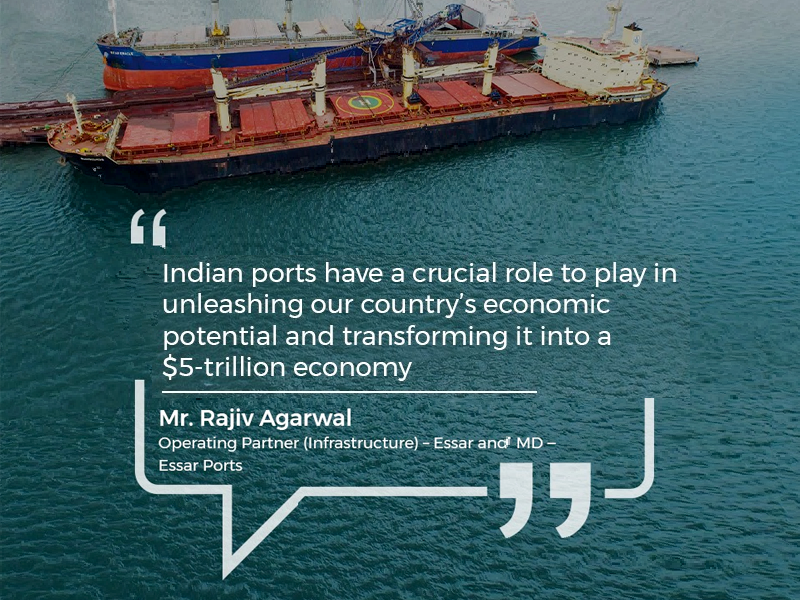Infrastructure creation is capital intensive with long gestation period, says RAJIV AGARWAL, Operating Partner, Infrastructure, Essar; and Managing Director, Essar Ports
EPC World (December 2021)

In an exclusive interview with EPC World magazine, Mr. Rajiv Agarwal, Operating Partner, Infrastructure, Essar; and Managing Director, Essar Ports said that Infrastructure creation is capital intensive with long gestation period. Below are excerpts from the interview.
Is the infrastructure sector moving with the desired momentum to attain the national goals of growth as envisioned by the government?
Yes, it is a steady process and gaining momentum in line with the Government’s vision. The sector lays the foundation for our Nation’s sustainable development. It enjoys intense focus from the Government through proactive policies and an enabling framework that would ensure time-bound creation of world-class infrastructure in the country. India plans to spend more than $1.4 trillion on infrastructure for projects identified under the National Infrastructure Pipeline, spanning transport, logistics, energy, water & sanitation, social & commercial infra and communication. These projects will help the country realise its vision of becoming a $5-trillion economy and this will enable the country to continue on an escalated growth trajectory until 2030.
What are the measures that will assist in the development of the sector?
Infrastructure creation is capital intensive with long gestation period. The sector is plagued with a plethora of projects, operations and market risks, with long term concessions and very little leeway to deviate. To support the sector following should be looked at, financing of the infrastructure projects is one area where we need more support from the Government as banks are risk averse for supporting the new investments; infrastructure finance companies should be promoted and empowered for funding of the infra projects; mechanisms to enable flexibility in long term concessions to ride out the evolving market dynamics, and other risks impacting projects and operations
What were the key infra announcements of 2021 and their impact according to you?
Government has been actively working in bolstering the economy. The Ministry of Ports, Shipping and Waterways has undertaken various measures and initiatives to boost the sector and economy. Some of the key initiatives undertaken are: various projects have come up for competitive bidding during last one year and many projects are under pipeline for the bidding, paving way for mechanisation and efficiency; government is supporting the sector through focus on port connectivity projects under Sagarmala; Major Ports Act 2021 is a very positive move for the sector. It will enable private players to fix the tariff based on market conditions, boosting fresh investments and growth in the sector; Gatishakti will pave way for holistic development across different ministries, ensuring ease in coordination and effective implementation in Infra sector; launch of Maritime Vision 2030 will pave way for global maritime leadership; National Infrastructure Pipeline & National Monetisation Plan will enable the infrastructure support required for Atmanirbhar Bharat. All these initiatives put together are expected to not only lower logistics cost but also improve the country’s competitiveness in the global markets.
What are some of the other policy initiatives and measures required to push the growth further in the sector?
The Indian government has been providing the much needed support to the Ports and Infrastructure sector with multiple reforms to mitigate the impact caused by the pandemic. The Ministry of Ports, Shipping and Waterways has undertaken various measures and implemented many initiatives to boost the sector and economy. However, the need of the hour for further boosting the ports and logistics sector are: support for existing PPP projects through incentives and by addressing their concerns; Tariff flexibility for old concessions in major ports (under different tariff regimes) is one area which private terminals are looking at. It will put old concessions in equal footing with new concessions in major ports and non-major ports; mechanisms to enable flexibility in long term concessions to ride out the evolving market dynamics, and other risks impacting projects and operations; and enhancing ease of low cost of finance to fund the projects. Indian ports have a crucial role to play in unleashing our country’s economic potential and transforming it into a $5-trillion economy, especially at a time when India is aiming to become Atmanirbhar.
How do you see yourself contributing towards the growth of the infrastructure sector?
At Essar, we have invested `11,000 crore in developing world-class fully mechanised terminals to stay futureready. Our mechanised facilities enable seamless flow of information and cargo. Additionally, all our terminals are scalable and come with the necessary infrastructure to enhance the capacity to cater to market requirements. We strongly aim to continue investing in the expansion of our capacity and implementing advanced technology to ensure visibility of cargo, handling cargo in the most efficient and environmentfriendly manner, and to manage bigger vessels with faster turnaround – paving way for lower logistics cost. Similarly, our innovative solutions that are embedded in technology will connect directly to customers through multimodal solutions.
As we grow, we continue to deliver state-of-the-art solutions by inculcating digital transformation and technology that can further give a sustainable advantage to our customers. Essar Ports will continue to expand in the existing line of business, as well as develop new assets, through identification and investment in right opportunities. We strongly believe that diversification through service offerings, customer mix and cargo will play a pivotal role going forward.
Source: EPC World (December 2021)